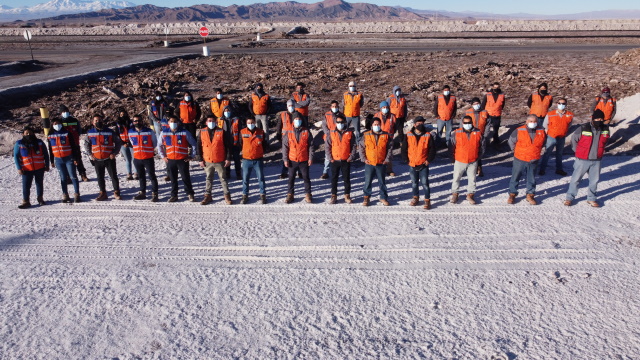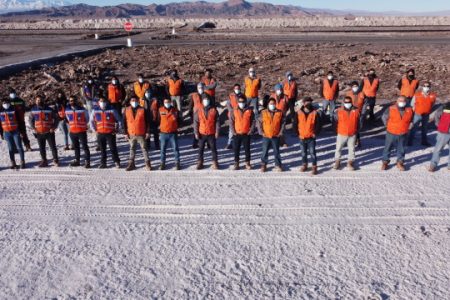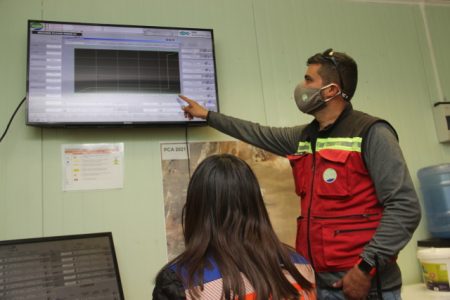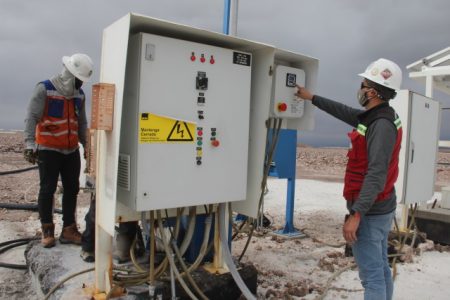
Moving Forward Down a Path of Sustainability and Excellence
09/Aug/2021
Reinvention was key to the current achievements of the mine team at Salar de Atacama. Thanks to a new orientation, and implementation of innovative technological tools and sustainability commitments made by SQM, its indicators are already beginning to show noteworthy results in the first half of 2021.
Mine operations at Salar de Atacama are a challenging and complex process every day, and are tied directly to diverse production goals for our Company’s growth, such as increasing brine extraction for producing lithium by 353,000 tons of LCE (lithium carbonate equivalent).
However, the Salar Production Department wanted to raise the bar for those objectives even further, challenging itself to reach more than 380,000 tons of LCE.
SQM’s commitment to the development of more sustainable and environmentally friendly processes makes this task even more interesting. Consequently, they also set the challenge of reducing their extraction quota to 1,280 liters per second.
Given these two important focal points (increasing extraction and reducing the extraction quota), the Salar de Atacama mine team has had to reinvent and orient its efforts to meet both challenges. To do this, they have defined 4 fundamental pillars for achievement: Productivity, Control and Management, Environment and Efficiency.
On the topic, Gilbert Maldonado, Salar Production Manager, highlights that the team’s efforts have been extremely relevant for these objectives because “we have managed to sustain and increase extraction (in tons of LCE) by 14% above budget, thanks to all the measures implemented by this area—along with support from M1—such as defining preferential ponds and automating the process using telemetry for those ponds. The latter is one of the most impressive measures since it enables variables of interest to be supervised online.”
The executive commented, “Our department has felt a big responsibility to the sustainability commitments that SQM made. We are seeking and encouraging all alternatives that help us achieve these goals. Therefore, we are proud of our leaders and their work teams for proposing this type of initiative to balance these two key corporate objectives: the productivity and sustainability of our processes.”
Maldonado added that strict control of pond operations and distribution systems has been fundamental, as has assurance of online monitoring systems in place since 2019 in Salar de Atacama.
Pillars
As mentioned, the success achieved is based on the “reinvention” driven by the Salar Mine Operations based on four pillars. Claudio Adones, Head of Operations at Salar de Atacama, explained that a strategy was drafted to boost productivity numbers by defining 45 ponds considered “preferential” because of their larger contribution of LCE to lithium extraction.
“We have focused, by prioritizing our resources, on achieving greater operational control, monitoring and tracking in order to increase availability. Likewise, the second step we took was to increase the efficiency of extraction, achieving a sustained net positive gain over the last four months. Based on this, we were 1,917 tons of LCE over budget, equivalent to an additional 15.2 tons LCE/day. All this has been achieved thanks to ongoing coordination and work toward a common goal with key areas such as Hydrogeology, Processes, Mine Maintenance, HDPE and Machinery, among others,” explained Adones, who is also an M1 change agent within the organization.
Regarding the “Control and Management” pillar, geographic macrozones were formed and assigned to teams of operators selected based on their skill set. Also, in conjunction with the Energy and Automation Department, the “Telemetry in 30 Reference Ponds” project was launched.
“The work involved using telemetry to control and monitor these ponds, which are visualized from the MOP Control Room. However, it will soon rely on a virtual platform that can be monitored from the Mine Superintendent’s office. This improvement considers a new control by level that optimizes pond extraction, looking to increase lithium production in Salar de Atacama,” according to Gerson Salas, the manager of that unit.
In addition, an operational database was generated, which provides the correct inputs for diverse dashboards developed using the Power BI application.
“These panels enable us to detect deviations in ponds or brine distribution systems in a timely manner, in order to conduct an “Online Analysis” that helps accelerate decision making based on diverse data such as: operating trends, failure reports, service requests, chemical variations, monitoring results, etc. These results can be seen annually, monthly, weekly and even daily, giving us an analysis potential that we can still harness advantages from,” explained Adones, who then added that these dashboards are in addition other dashboards for tracking projects that are important for the area and the department such as: outfitting new ponds handed over by the Hydrogeology Department, electrifying ponds and controlling diesel use for purposes of CO2 emissions.
Environment and Efficiency
In line with the importance of our processes related to the environment and the value of sustainability, the Salar Mine Operations Division is also improving its methods by implementing “automatic sampling” to optimize decision making and boost the reliability of these analyses.
“On the other hand, we have detected opportunities for decreasing CO2 emissions into the environment. For example, we are electrifying ponds that work with diesel generators. In the first phase we managed to electrify 35 ponds and currently are in a second phase with 21 additional ponds. Thanks to this work, we cut our annual projected CO2 tons by 58%,” commented the Head of Operations in Atacama.
Another interesting effort by the Mine Operation’s development area is its ongoing search for technological alternatives that are aligned with the concept of industry 4.0. One example is its work with drones that can follow the extensive lengths of piping to detect possible deviations in brine transport. This is also tied to safety since it reduces the operators’ direct interaction with the piping. This is in addition to another pilot phase initiative to incorporate and use thermographic cameras in drones.
“For all this and more, I would like to congratulate the Salar de Atacama mine team for introducing and developing these proposals aligned with SQM’s objectives, in an aim to achieve our production goals in a sustainable manner. I would also like to take advantage of this opportunity to encourage all our team members to come up with and propose ideas for changes in their areas, following or continuing along this same line of development,” Maldonado said proudly, reflecting on the efforts of the workers and supervisors on the Salar de Atacama mine team.
Congratulations everyone…and keep moving forward down a path of sustainability and excellence!



